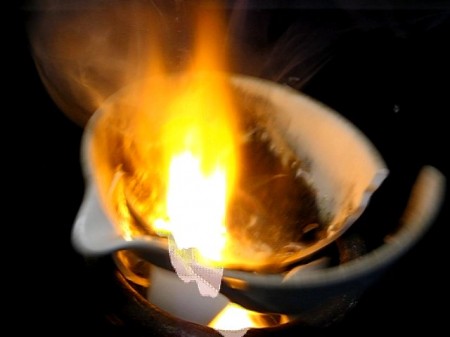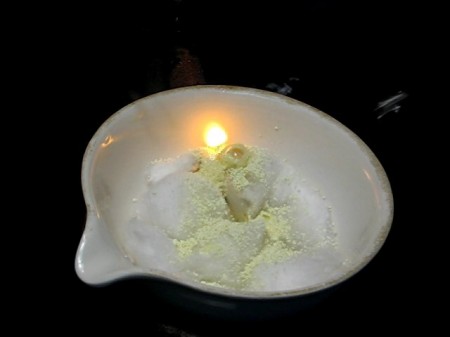I went looking through the chemicals the other day, and I decided that it had been too long since I recorded a good chemical demonstration video.
So I pulled out some sodium peroxide, Na2O2. The MSDS sheet looks interesting:
DANGER! CORROSIVE. STRONG OXIDIZER. CONTACT WITH OTHER MATERIAL MAY CAUSE FIRE. CAUSES SEVERE BURNS TO EVERY AREA OF CONTACT. HARMFUL IF SWALLOWED OR INHALED.
Also:
Contact with combustible, organic, or oxidizable substances may cause extremely violent combustion. May react explosively in contact with large amounts of water.
it’s a strong oxidizer, plus it reacts with water? If there were ever a substance tailor-made for a cool reaction demonstration, sodium peroxide would have to be it. So let’s see … what would happen if you took some sodium peroxide, sprinkled it on top of a few combustible cotton balls, and then added water?
No, really. I’ve found this demonstration mentioned in several of my chemistry books. (Ever notice how the more impressive chemical demonstrations involve doing things the MSDS specifically warns against?)
The idea behind this particular demonstration is that the reaction of sodium peroxide with water will release hydrogen peroxide and quite a bit of heat.
Na2O2 + 2H2O –> 2NaOH + H2O2 … and lots of heat.
Under these conditions hydrogen peroxide also decomposes, releasing oxygen – which will speed up any combustion that happens to be occurring.
2H2O2 -> 2H2O+O2
In short, we get oxygen and a lot of heat. This usually makes for a fun demonstration. Take a look.
Looking a little more closely, you can see that after only a few seconds, the cotton catches fire.
And after several seconds more, the evaporating dish just can’t handle any more.

Bang! You can't see it in the video, but there's a sand bath just below the evaporating dish - in case something like this were to happen.
… and this is why we always wear safety glasses when doing chemical demonstrations. But perhaps I should have given the camera some safety glasses, too?
Tags: chemical demonstration, cotton, Science, sodium peroxide, water

